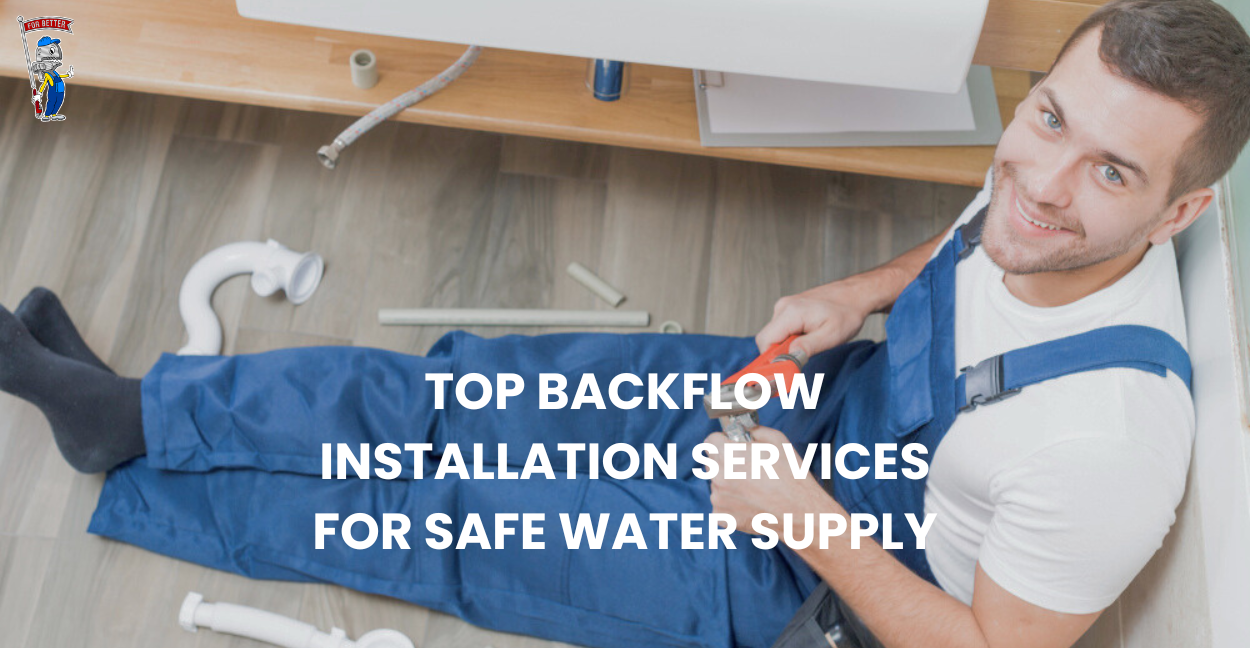Backflow installation services are essential for maintaining safe and clean water supplies in residential, commercial, and industrial settings. Understanding the importance of backflow prevention, the installation process, and the benefits it brings can help you make informed decisions about protecting your water system. In this article we will discuss the details of backflow installation services, covering everything from the basics to advanced considerations.
Key Components of Backflow Installation Services
Backflow installation services encompass several critical components, each playing a vital role in ensuring the effectiveness and reliability of the backflow prevention system. Here are the key components explained in detail:
1.) Backflow Preventer Selection
Selecting the right type of backflow preventer is crucial to the success of the installation. Various backflow preventers are designed to handle different situations and contamination risks. The main types include:
a) Double Check Valve Assembly (DCVA)
A Double Check Valve Assembly (DCVA) consists of two independent check valves that are installed in a series. It provides reliable protection against low-to-moderate hazards. DCVAs are commonly used in fire sprinkler systems, lawn irrigation systems, and other applications where potential contaminants are not highly toxic.
b) Reduced Pressure Zone Assembly (RPZA)
A Reduced Pressure Zone Assembly (RPZA) is one of the most reliable types of backflow preventers, offering high-level protection against both low and high hazards. It includes two check valves and a pressure relief valve situated between them, ensuring that any backflow is immediately discharged away from the potable water supply. RPZAs are typically used in industrial plants, hospitals, and laboratories.
c) Pressure Vacuum Breaker (PVB)
A Pressure Vacuum Breaker (PVB) is designed to prevent back-siphonage and backflow in low-hazard situations. It features an air inlet valve that opens to break the vacuum whenever the upstream pressure drops. PVBs are commonly used in irrigation systems and other non-health hazard environments.
d) Atmospheric Vacuum Breaker (AVB)
An Atmospheric Vacuum Breaker (AVB) is a simple and effective device for preventing back-siphonage. It contains a check valve and an air inlet valve that allow air to enter the system, breaking the siphon. AVBs are often used in residential hose bibs and small irrigation systems.
2.) Site Assessment
Conducting a thorough site assessment is an essential step in the backflow installation process. This involves evaluating various factors to determine the most suitable location for installing the backflow preventer. Key considerations include:
a) Water Pressure
Understanding the water pressure in the system is crucial for selecting the appropriate backflow preventer and ensuring its effective operation.
b) System Layout
Examining the layout of the plumbing system helps in identifying the best installation points for optimal protection and accessibility.
c) Potential Contamination Sources
Identifying potential sources of contamination helps in assessing the risk level and determining the type of backflow preventer needed.
d) Accessibility for Maintenance
Choosing a location that allows easy access for regular maintenance and testing is important for the long-term functionality of the backflow preventer.
3.) Professional Installation
Professional installation by certified technicians is critical to ensure the backflow preventer functions correctly and complies with regulatory standards. The installation process involves:
a) Precise Measurements
Accurate measurements are taken to ensure the backflow preventer fits correctly within the plumbing system.
b) Secure Fittings
Proper fittings and connections are made to prevent leaks and ensure the backflow preventer operates effectively.
c) Adherence to Local Codes and Standards
Compliance with local building codes and industry standards is essential to ensure the installation meets all legal and safety requirements.
4.) Testing and Certification
After the installation, rigorous testing is conducted to verify the functionality of the backflow preventer. This step includes:
a) Initial Testing
Certified testers perform initial tests to ensure the backflow preventer is working correctly and preventing backflow as intended.
b) Ongoing Testing
Regular testing is required to maintain the certification and ensure continued protection. Annual testing is typically mandated by local regulations.
c) Issuance of Certification
Once the backflow preventer passes the tests, a certification is issued, confirming that the system complies with regulatory requirements and is safe for use.
5.) Regular Maintenance
Routine maintenance is essential for the longevity and reliability of the backflow preventer. Maintenance tasks include:
a) Visual Inspections
Regular visual inspections help identify any signs of wear, damage, or potential issues that may need attention.
b) Functional Testing
Periodic functional testing ensures that the backflow preventer continues to operate correctly and efficiently.
c) Replacement of Worn Components
Timely replacement of worn or damaged components prevents failures and maintains the integrity of the backflow prevention system.
6.) Documentation and Record-Keeping
Proper documentation and record-keeping are vital for compliance and future reference. This includes:
a) Installation Records
Detailed records of the installation process, including measurements, fittings, and compliance with codes.
b) Test Reports
Documentation of all initial and ongoing test results, including any corrective actions taken.
c) Maintenance Logs
Records of all maintenance activities, inspections, and component replacements performed over time.
Choose Backflow Services Done Right for professional backflow installation services that prioritize safety, compliance, and reliability. Safeguard your water supply with our expert team committed to protecting public health and maintaining system integrity. We proudly serve multiple areas in Virginia, including Alexandria, Annandale, Arlington, Burke, Fairfax, Clifton, McLean, and many more. Trust us to deliver exceptional backflow prevention solutions tailored to meet your property’s needs.
Why Choose Backflow Services Done Right for Backflow Installation Services
At Backflow Services Done Right, we specialize in providing professional backflow installation services to safeguard your water supply system. Here’s why you should choose us
1. Expertise in Backflow Prevention
Our team possesses extensive expertise in backflow prevention. With certified technicians and ongoing training in industry standards, we ensure knowledgeable installation of various types of backflow preventers.
2. Thorough Site Assessment and Consultation
Before installation, we conduct thorough site assessments and consultations. We assess water pressure, system layout, and contamination risks to recommend the most suitable backflow preventer and installation location for optimal protection.
3. Strict Compliance with Regulations
We strictly adhere to local and national regulations governing backflow prevention. Our deep understanding of plumbing codes, permit requirements, and testing protocols ensures that all installations comply with regulatory standards and maintain certification.
4. Emphasis on Quality Assurance and Testing
Quality assurance is paramount in our installations. We conduct rigorous testing post-installation to verify the functionality of the backflow preventer, ensuring effective prevention of backflow. Our regular maintenance schedules uphold compliance and ensure system reliability.
5. Transparent Pricing and Contracts
We provide transparent pricing with detailed quotes that outline costs for equipment, labor, permits, and additional services. Our clear contracts or service agreements specify terms, warranties, and guarantees, ensuring transparency in billing practices and service expectations.
6. Responsive Customer Service
At Backflow Services Done Right, we prioritize exceptional customer service. We are responsive to inquiries, maintain clear communication throughout projects, and offer timely support for maintenance, repairs, or emergency services. Our commitment to accessibility and reliability enhances overall client satisfaction.
7. Proven Track Record and Customer Satisfaction
We boast a proven track record of successful installations and satisfied customers. Positive reviews and referrals speak to our reliability, professionalism, and ability to deliver high-quality service. Choosing us means choosing a provider with a strong reputation for safeguarding your water system effectively.
8. Commitment to Ongoing Support and Education
We are committed to ongoing support and education. We inform our clients about maintenance schedules, provide educational resources on backflow prevention, and proactively communicate updates or changes in regulatory requirements. Our dedication ensures informed decision-making and long-term system reliability.
Common Backflow Installation Mistakes
At Backflow Services Done Right, we understand the importance of proper backflow installation to safeguard your water system. Here are three common mistakes to avoid:
1. Incorrect Backflow Preventer Selection
Choosing the wrong type or size of backflow preventer is a critical mistake. Each backflow preventer is designed for specific applications and levels of hazard. Installing an incorrect preventer can lead to inadequate protection against backflow events, compromising water quality and system integrity.
2. Improper Installation Location
The location of the backflow preventer is crucial for its functionality. Installing it in a location prone to flooding, extreme temperatures, or physical damage can undermine its effectiveness. Improper placement may also hinder access for testing, maintenance, or repairs, leading to compliance issues and potential system failures.
3. Lack of Regular Testing and Maintenance
Neglecting regular testing and maintenance is another common mistake. Backflow preventers require periodic testing to ensure they are functioning correctly and preventing backflow as intended. Failure to conduct routine tests can result in unnoticed malfunctions, rendering the preventer ineffective and exposing the water supply to contamination risks.
We have also written a detailed article covering all common backflow preventer installation mistakes. Check out to learn more about it.
FAQs
1.) What types of properties require backflow preventers?
Backflow preventers are essential for various properties, including residential homes, commercial buildings, industrial facilities, and public institutions. They are mandated by plumbing codes to mitigate contamination risks and ensure water safety.
2.) How do I know which type of backflow preventer is suitable for my property?
The type of backflow preventer required depends on the level of hazard associated with the property and the specific plumbing configuration. Our certified technicians assess your property and recommend the appropriate type of preventer based on regulatory requirements and system needs.
3.) What are the common signs that my backflow preventer needs maintenance?
Signs that your backflow preventer may need maintenance include visible leaks, reduced water pressure, unusual noises during operation, or failure of regular testing. Regular maintenance and testing ensure the preventer functions effectively to protect your water supply.
4.) How often should backflow preventers be tested?
Backflow preventers should be tested annually or as required by local regulations. Regular testing ensures the preventer operates correctly and meets compliance standards for protecting the water supply from contamination.
5.) What should I do if my backflow preventer fails a test?
If your backflow preventer fails a test, our technicians will diagnose the issue and recommend necessary repairs or adjustments. Prompt action is essential to maintain compliance and ensure the ongoing protection of your water system.



